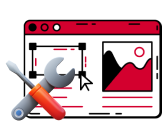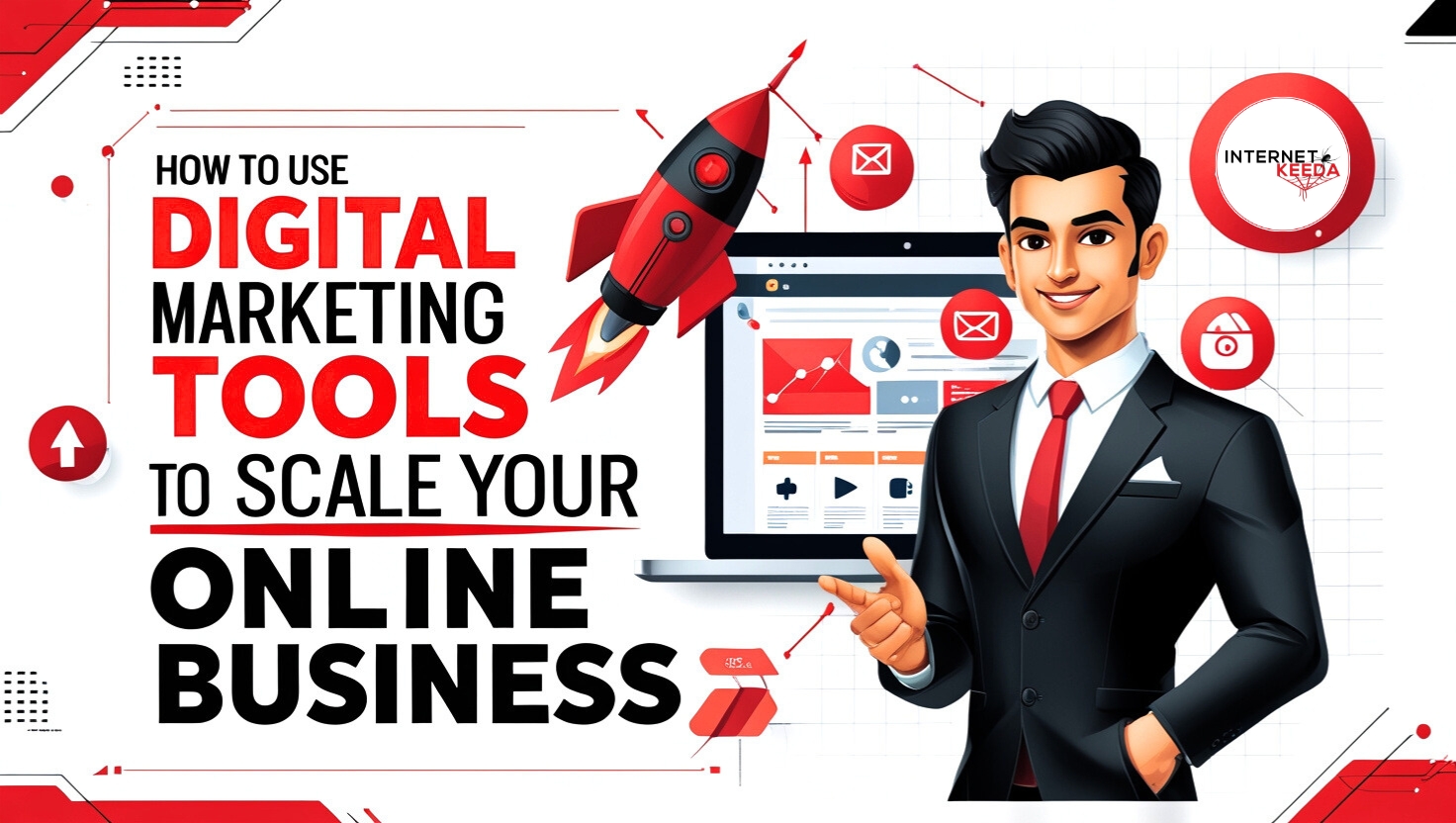Introduction: From Small Steps to Big Growth
Scaling an online business often feels like trying to climb a mountain with no clear path. You’ve got products, a website, maybe even a few sales coming in. But then what? How do you move from surviving to thriving? From getting by to breaking through?
The truth is, no one builds a strong, scalable business on effort alone. What separates businesses that plateau from those that soar is the intelligent use of digital marketing tools. These tools don’t just automate tasks. They create structure, offer insight, and give you the ability to reach more people without stretching yourself thin. When used strategically, they become the very foundation of your growth.
This article is a deep dive into how you can use these tools to not only get more done but to grow with purpose. Whether you’re running a boutique brand on Shopify, selling digital courses, or managing a service-based business from your laptop, this guide will walk you through how the right tools unlock scalability at every level.
Knowing What to Automate and What to Own
Not everything can or should be automated. Some parts of your business need your personal touch. Others drain your energy and stall your growth. The first step in scaling with tools is understanding which parts of your business are holding you back.
Take content scheduling, for example. Manually posting on Instagram every day at 10 a.m. might seem manageable at first. But over time, it becomes a distraction. Social media schedulers like Buffer, Later, or Publer allow you to create, schedule, and monitor your content in batches. This way, you stay present online without being constantly interrupted.
Email marketing is another space where tools offer huge leverage. Platforms like Mailchimp, ConvertKit, and Moosend help you build lists, segment audiences, and send campaigns that feel personal but are entirely automated. You write once, and the system keeps working while you sleep.
Using SEO Tools to Multiply Visibility
Scaling online is about traffic. And sustainable traffic rarely comes from ads alone. That’s where SEO tools step in. They help you get found when people are searching for exactly what you offer.
Google Search Console shows you which pages get clicks and which keywords bring people in. Tools like Ubersuggest and Ahrefs offer even deeper insight, helping you identify content gaps, track rankings, and spy on competitors.
Here’s where the magic happens: once you create optimized content based on these tools, that content can continue to bring traffic for months or years. It’s like building an asset. One blog post, if positioned well, could bring in hundreds of visitors a week without additional effort.
Streamlining Analytics to Make Smarter Moves
If you can’t measure it, you can’t improve it. Scaling requires data. And while Google Analytics has long been the gold standard, newer tools like Fathom Analytics, Matomo, and Piwik Pro are rising in popularity for privacy-conscious businesses.
Tracking where people come from, what they click, and where they drop off gives you insight into what’s working and what needs fixing. You stop guessing. Instead, you start making decisions based on real user behavior. That’s where scaling begins.
Traffic Without Trust Is Just a Number: Using SEO Tools to Grow the Right Way
It’s easy to get excited about traffic. When your analytics dashboard lights up with new visitors, it feels like something is working. But scaling isn’t about visitors. It’s about getting the right people to your site at the right time, and turning that interest into income. That’s where SEO tools can do more than just help can guide.
In India, over 80% of online buyers start their journey with a Google search, according to a 2024 Google India Consumer Trends report. That means if your business isn’t showing up in those early search results, you’re practically invisible. But this isn’t just about ranking first. It's about understanding what your audience is searching for, what questions they’re asking, and what kind of content they trust. Tools like Ubersuggest, Semrush, and Ahrefs aren’t just for big agencies anymore. Even free versions can uncover keyword patterns, competitor strategies, and backlink opportunities that small business owners can act on immediately.
Take the example of Green Looms, a sustainable clothing brand based in Jaipur. They started with zero online presence in early 2022. By using Semrush’s keyword gap analysis and Surfer SEO’s content planner, they identified long-tail keywords like “organic cotton shirts India” and “breathable office wear for summer” with low competition but high intent. Within six months, their blog posts began to rank. One article alone, “Why Organic Cotton Matters in India’s Heat,” brought in 12,000 visits monthly. And these weren’t just visits; they converted. Product sales from organic search increased by 54%, according to their founder’s 2023 Business Insider interview.
What made the difference? Consistent SEO-focused content creation, backed by the right tools and genuine customer understanding. Tools helped speed up the process, but it was the brand’s clarity and content consistency that made it scale.
This is why digital marketing tools aren’t magic bullets, but multipliers. They don’t create value from nothing. They amplify what’s already there. If you understand your customer and commit to serving them through content, the tools help you get seen and trusted faster.
Building Relationships While You Sleep: Email Automation That Feels Personal
Running an online business means you're always trying to be in ten places at once. Answering inquiries, writing content, fulfilling orders, and brainstorming new offers, it never really stops. And yet, some of the most important work happens quietly behind the scenes. That’s what email automation is for. Not just to save time, but to deepen your customer relationships without needing to be online every moment.
Look at how email tools have evolved. Once, it was all about newsletters. Now, platforms like MailerLite, Brevo (formerly Sendinblue), ConvertKit, and Moosend give you automation that feels custom-made. You can trigger a welcome series when someone downloads a free guide, or send tailored follow-ups based on what product they viewed. You’re not just sending emails. You’re building a story, one that unfolds differently depending on who’s reading.
What’s most powerful is how accessible this is now for small Indian businesses. A case in point is The Kesar Co., a homegrown skincare startup from Pune. They started using Mailchimp’s free tier in 2023 and later switched to Brevo to manage their growing list. They didn’t just send weekly updates. They built email sequences based on customer journeys. If someone added an item to the cart and didn’t check out, they received a reminder with product benefits and real customer reviews. If they bought something, they got a care guide for the product and a discount on their next purchase. By the end of 2024, 39% of their repeat sales came from email flows alone, and they saved over 20 hours each month thanks to automation.
What makes these tools powerful isn’t just the tech. It’s how they allow you to show up for your audience, even when you’re not manually writing every word. They let you be consistent. They let you stay relevant. They allow your brand to feel warm and responsive, without burning you out in the process.
Email isn’t dead. It’s just changed. And for small businesses trying to scale without losing their voice, it’s one of the most intimate, affordable, and effective channels you can use, especially when you set it up smartly once and let it work for you every day after.
Small Budgets, Big Impact: Ad Tools That Turn Every Click Into Data Gold
Running ads online used to be a gamble. You’d boost a post on Instagram, set a budget on Google Ads, and cross your fingers. Sometimes it worked. Often, it didn’t. But things have changed. Now, smart digital marketing tools help you learn from every click, every scroll, and every skipped ad. These insights don’t just report what happened. They tell you what to do next.
For small Indian businesses, where every marketing rupee counts, platforms like Adzooma, SpyFu, Madgicx, and Facebook Ads Manager aren’t just tools. They’re strategic partners. Adzooma, for instance, analyzes your Google and Facebook ads in real-time and gives you suggestions to fix poor-performing campaigns. It’s like having an ad coach sitting next to you, minus the consulting fees.
A fantastic example comes from a boutique travel company based in Jaipur. With a modest monthly ad spend of ₹15,000, they used Madgicx to test multiple creatives, track performance in real-time, and automatically pause underperforming ads. Over six months, their cost-per-lead dropped by 42%, and their total bookings increased by 29%. What changed? Not the spend. Just the clarity. They knew what worked, and they stopped wasting time and money on what didn’t.
And that’s the heart of it. These tools are not just dashboards. They’re decision-makers. They show you which keywords are too expensive, what demographics are converting, and even which time of day your audience is most active. For small businesses trying to scale, this means you no longer need a full agency or a data scientist to make informed advertising choices. The tools do the heavy lifting. You just need to listen to what they’re telling you.
This kind of clarity is empowering. It removes the fear of advertising. You’re no longer guessing. You’re experimenting, optimizing, and learning. One ad at a time, you’re building something sustainable, a marketing system that doesn’t just work, but gets smarter with every campaign.
Data That Speaks: Analytics Tools That Don’t Just Track, They Teach
There’s something oddly humbling about checking your website’s traffic in the middle of the night. Maybe you were hoping that blog post would go viral. Or maybe you’re just curious about who’s reading your landing page in real-time. Either way, good analytics tools don’t just show you traffic, they tell you what’s happening beneath the surface.
For small business owners in India, especially those without in-house tech support, platforms like Google Analytics 4, Matomo, Clarity by Microsoft, and Piwik PRO make data feel a little less overwhelming and a lot more useful. These tools break down who’s visiting your website, where they came from, how long they stayed, what they clicked, and where you lost them. More importantly, they don’t require a degree in statistics to understand the story behind the numbers.
Google Analytics 4, for instance, helps you track user journeys across devices and platforms. So, if someone discovers your Instagram Reel, clicks on your site, checks your pricing page, and leaves, you’ll know exactly where they dropped off. That insight alone could be the difference between a lost visitor and a future customer. Maybe it was the pricing. Maybe it was a slow-loading page. With the right data, you can test, tweak, and improve.
There’s also Hotjar and Clarity for behavior analytics. These tools let you watch real recordings of how users interact with your site. Not to spy but to see what’s frustrating or confusing them. Maybe people keep trying to click a button that doesn’t work. Or maybe your mobile layout isn’t scrolling correctly on certain devices. Without these tools, you'd never know. With them, you learn how your website feels through your customer’s eyes.
Consider this: a growing organic skincare brand based in Surat started using Microsoft Clarity on their Shopify site. Within days, they discovered that 80% of users on mobile were abandoning checkout on the final step. The reason? Their coupon box covered the ‘Place Order’ button. One small change and cart abandonment dropped by nearly 18% in a week.
These tools don’t just report. They reveal. They show you what’s broken before you lose more leads. They highlight patterns you wouldn’t see on your own. And they empower you to make smarter decisions every week, not just during end-of-quarter reviews.
In the long run, tracking your marketing without analytics is like trying to drive blindfolded. You might move forward, but it’s messy and unpredictable. When you let the data guide you, calmly, and in real time, you give your business the insight it needs to grow faster and smarter.
Staying Aligned and Connected: The Tools That Power Collaboration and Customer Relationships
Running an online business doesn’t mean working alone. Whether you’re juggling a virtual assistant, a content writer, a designer, or just trying to stay on top of client follow-ups, collaboration is everything. Without a system, things slip through the cracks. Emails get buried. Deadlines are missed. Clients feel ignored. It’s not about working harder, it’s about building smarter workflows that keep everyone in sync.
Tools like Trello, ClickUp, and Asana have changed the way small businesses in India manage their day-to-day operations. You don’t need a project manager to feel organized anymore. These platforms turn tasks, timelines, and goals into visual dashboards that make it easy to track progress, assign roles, and avoid that dreaded last-minute scramble. You can create boards for campaigns, to-do lists for your launch funnel, and timelines for upcoming seasonal sales, all without endless email chains or confusing spreadsheets.
What’s powerful about these tools is that they meet you where you are. A boutique clothing brand in Jaipur, for instance, used to rely on WhatsApp and Excel to run everything from inventory updates to influencer campaigns. It worked until it didn’t. When they switched to ClickUp, it was a game-changer. Suddenly, marketing plans, supplier updates, and content approvals were all in one place. Team members stopped overlapping or missing steps. Productivity soared. And for the first time, the founder could focus on strategy instead of chasing updates.
Then there’s the matter of managing your actual customer relationships, the real heartbeat of your business. That’s where CRM platforms like Zoho CRM, HubSpot CRM, Freshsales, and Pipedrive come in. They’re not just for big enterprises anymore. These tools are incredibly intuitive and affordable, especially when you’re starting and need to build trust with every single lead.
Imagine this: someone downloads your free guide or fills out a product inquiry form. With a CRM, that lead isn’t just another email in your inbox. They’re entered into a system. You can see where they came from, what they’re interested in, and when they last interacted with your brand. From there, you can send a follow-up, nurture them with helpful emails, or reach out with a custom offer. It’s personal without being manual. And it’s efficient without losing that human touch.
Many Indian solopreneurs have found huge value in combining Zoho CRM with WhatsApp Business integrations. It allows them to stay on top of every conversation, schedule reminders, and respond faster, which is especially crucial in markets where messaging apps dominate communication.
At the end of the day, growth doesn’t happen by accident. It comes from the clarity that collaboration tools give you and the consistency that CRMs allow you to build with your customers. These platforms might not be flashy, but they’re the difference between surviving and scaling. They help you do more with less, say yes to bigger opportunities, and keep your focus on what matters most, building a business you’re proud of.
Turning Emails into Revenue: How Automation Becomes Your Quietest Salesperson
It’s easy to think email is old school. With social platforms grabbing attention every second, some small business owners question if email still delivers. But the numbers don’t lie. According to a 2024 report by Litmus, email marketing still has an average ROI of ₹3,500 for every ₹100 spent. That’s not a typo. And it’s not just for tech companies or ecommerce giants — it’s working wonders for local entrepreneurs, niche product creators, and solopreneurs across India.
The magic? Automation. It’s not about writing more emails. It’s about writing fewer, smarter ones that work for you while you sleep.
Take tools like MailerLite, Moosend, Mailercloud, and the powerhouse ConvertKit. These aren’t just platforms to send a newsletter. They’re entire systems designed to help you guide a visitor from curious to converted. You can set up a welcome sequence that warms up leads, share your brand story over a few days, and subtly nudge them toward your best product or service, without sending a single email manually.
Let’s say you run a handmade organic skincare brand out of Coimbatore. A customer visits your website and signs up for your free skin health guide. That’s not the end. That’s the beginning. Your email tool immediately sends them the guide, then follows up with a personalized routine suggestion, a behind-the-scenes look at how your products are made, a few testimonials, and finally, a limited-time discount. Each email feels timely. It feels personal. But you wrote and scheduled all of them once.
For business owners trying to grow without adding more hours to their day, this is the kind of invisible engine that makes scaling possible. You’re not chasing every sale. You’re building a runway of trust and value that brings people back again and again.
In India, we’re also seeing a growing use of email plus SMS combos, especially with tools like Sender.net and Omnisend that offer this hybrid model. Why does this matter? Because while emails are great for content and storytelling, SMS hits immediately when urgency matters — like restock alerts, event reminders, or flash sales. Together, they keep your audience close, informed, and more likely to act.
There’s also a rising trend among Indian creators, from language tutors to finance influencers, using ConvertKit’s segmentation features to group their audiences and tailor content. Instead of blasting the same tips to everyone, they deliver more precise value. One subscriber learns how to start freelancing in tier-2 cities. Another gets advice on pricing digital services globally. That level of specificity feels intimate, even if you’re sending to thousands.
What’s important here is not to get overwhelmed. Start simple. One lead magnet. One welcome series. One product pitch. Then iterate. Automation isn’t just about technology. It’s about understanding your audience, mapping their journey, and showing up with the right message at the right moment, even when you're offline.
The Quiet Power of Smarter Social Media Tools
Every small business has faced that moment, staring at an empty Instagram caption box late at night, wondering what to post tomorrow. Maybe you have a new product, maybe you’re planning a sale, or maybe you're just trying to stay visible in the endless scroll of everyone’s feed. But when your business depends on visibility and engagement, that pressure to post never really disappears. That’s where the right social media tools step in, not to take your voice away, but to help you use it more strategically.
Let’s start with a simple truth. The most successful small businesses on Instagram, YouTube, or LinkedIn aren’t necessarily posting more than you. They’re posting smarter. They’ve replaced guesswork with scheduling, audience insight, and AI-enhanced writing support, all packed into platforms like SocialBee, Publer, ContentStudio, and Metricool.
These aren’t just scheduling calendars. They’re clarity creators. With ContentStudio, for example, you can identify trending topics your audience is already searching for and plan content around them. With SocialBee, you can segment your posts by category, product education on Mondays, customer stories on Wednesdays, tips on Fridays, and the platform rotates and schedules them without a hitch.
It’s the difference between showing up randomly and showing up with rhythm. And rhythm builds trust.
Let’s take a real scenario. A boutique fashion brand based in Jaipur used to post sporadically, usually around new collections or festive sales. With Publer, they planned 60 days of content. They batched photoshoots, wrote captions with AI assistance, and scheduled everything in one go. The result? Engagement went up 43 percent. But more importantly, the founder reclaimed her weekends, time she now spends on vendor sourcing and creative design instead of writing captions at 2 a.m.
What’s even more interesting is how these tools are adapting to India’s multilingual audience. Tools like Predis.ai now offer auto-translation and regional trend insights, so a small business in Pune can tailor their Marathi content while still reaching a pan-Indian audience. That kind of reach used to take a full marketing team. Now, it takes a few clicks and some smart planning.
And if you’re in the business of building your brand, whether you're a coach, consultant, or content creator, these tools help keep your presence alive across multiple platforms without making you feel like a hamster on a wheel. You write once, tweak the format, and distribute across Instagram, LinkedIn, Facebook, and even YouTube Shorts in minutes.
What you’ll notice after a few weeks is that social media stops being reactive. You’re not scrambling anymore. You’re telling a cohesive brand story, building anticipation, and creating consistency, and that consistency translates into followers who trust you, share your content, and eventually become your most loyal customers.
The irony of social media is that it rewards authenticity but demands efficiency. These tools help you strike that balance. You stay human in your messaging, but you automate the logistics. And in a digital economy where time is your most valuable currency, that’s a trade worth making.
Analytics Tools That Make Sense
Running an online business often feels like navigating in fog. You post, promote, and experiment, but without the right feedback, you're just hoping it all sticks. That’s where analytics comes in. But not just any analytics, we’re talking about tools that go beyond generic charts and tell you something useful. For small businesses trying to scale, these tools turn raw traffic into real decisions.
It starts with clarity. Tools like Google Analytics 4, Zoho Analytics, and Matomo have become much more user-friendly over the last two years. You no longer need a full-time data analyst to understand what’s happening on your site. With pre-built dashboards and visual reports, you can see where your traffic is coming from, how people move through your site, and when they drop off.
Let’s say you’re an online stationery brand based in Ahmedabad. You’ve been running Google Ads and posting on Instagram, but you’re not sure which one is driving sales. With GA4, you can track user journeys in real time. Maybe you find that most purchases start with an Instagram story swipe-up, not a Google search. That insight alone could help you double down on Instagram and reduce ad spend wastage by thousands of rupees over a year.
Then there are platforms like Hotjar that let you watch how users behave. Where do they click? Where do they scroll past? Where do they hesitate? This isn’t just data, it’s psychology. And for businesses focused on conversions like SaaS startups or eCommerce brands, that understanding is gold.
But what’s truly changed in 2024 and 2025 is how accessible these tools have become for Indian small businesses. A few years ago, deep data insights felt like a corporate luxury. Now, with tools like Clarity by Microsoft, even a home-run bakery can analyze customer heatmaps and optimize its website layout in a few clicks.
And let’s not forget ROI tracking. Funnel.io and Supermetrics let you pull data from all your ad platforms, email campaigns, and sales channels into one clean dashboard. You’re no longer guessing how each campaign performs. You can see the cost per lead, customer lifetime value, and ROI on every rupee spent.
What’s most empowering about these analytics tools is not just the visibility, it’s the confidence. You no longer rely on gut feeling or guesswork. You test, measure, and iterate. And that mindset shift is what separates the businesses that hustle endlessly from the ones that scale strategically.
When you start listening to the numbers, your marketing starts working for you. You stop feeling reactive and start feeling in control. And in the noisy, fast-moving world of digital commerce, that control is everything.
Design That Converts the Creative Tools for Visual Storytelling
There was a time when good design felt out of reach for small business owners. You either needed to hire a designer, spend hours learning complicated software, or settle for something that looked, well, homemade. That’s changed not just because of better tools, but because creativity itself has become more accessible, more collaborative, and more automated.
Enter the new wave of design platforms. Tools like Canva, VistaCreate, and RelayThat have gone far beyond being templates in a box. They now function as full-fledged creative assistants. You can build your brand identity, maintain design consistency, and create everything from business cards to TikTok ads all in one place.
Let’s take the example of a homegrown skincare brand in Pune. They’re juggling product launches, influencer collaborations, and weekly promotions. Instead of outsourcing design for every campaign, they use Canva Pro. With Brand Kits, they’ve uploaded their logo, fonts, and color palette. Every time they or a team member creates something new, the tool nudges them to stay visually on-brand. That’s consistency, the kind that builds trust with your audience without needing a graphic design degree.
Then there’s Adobe Express, which brings the Adobe legacy into a simplified interface. It helps small business owners get that polished, high-end look with far less effort. You can remove backgrounds, animate text, and generate content in the exact dimensions needed for Facebook, YouTube, or email banners. These features used to be locked behind paywalls or required heavy desktop apps. Now they’re in your browser or mobile phone, waiting to be used between meetings or during your morning commute.
But design isn’t just about beauty. It’s about clarity. It’s about creating messages that connect quickly and stick in people’s memories. That’s why creative tools like Lumen5 and Pictory, both powered by AI, are quietly becoming favorites among content creators and service-based businesses. They help you convert blog posts, interviews, and product demos into short, punchy videos that perform well on Instagram and YouTube Shorts.
In 2025, we’ve also seen a rise in design tools that collaborate across teams. Platforms like Figma and Visme allow marketing teams, copywriters, and designers to work together in real time. Even freelancers and agencies are inviting clients directly into these tools, which cuts down on endless email threads and rounds of revisions.
What all this means is that creative excellence is no longer a bottleneck. It’s no longer something that slows you down. With the right tools, small businesses in India can craft visuals that are just as compelling, just as professional, and just as scroll-stopping as those from brands with million-dollar budgets.
And more importantly, they can do it without burning out.
Content Marketing Tools that Turn Ideas into Influence
Content is no longer optional. It’s the engine behind discovery, trust, and conversion. But for small business owners juggling a dozen roles at once, creating quality content consistently can feel impossible. The good news is, modern content tools are built not just to publish, but to guide, support, and even think alongside you.
Imagine a solopreneur running an organic tea business from Darjeeling. She knows storytelling matters, and she’s got a great story to tell about local farmers, mountain herbs, and ancient wellness rituals. But between managing suppliers, handling packaging, and dealing with shipping delays, where’s the time to write a blog, send a newsletter, or update Instagram? That’s where tools like WriterZen, Frase, and Scalenut come in.
These platforms do more than generate content. They help define structure, pull in research, and even suggest SEO-driven outlines based on what people are actively searching for. It’s like having a strategist, writer, and SEO expert whispering over your shoulder, quietly turning your knowledge into marketing that works.
Take Scalenut, for instance. It’s become particularly popular in India because it understands the local content landscape. When a startup in Hyderabad wanted to break into the online learning space, they used Scalenut to map out a three-month content calendar, aligned with what parents were Googling before school season began. The result? A 43 percent boost in organic traffic in just eight weeks. That kind of lift is the difference between waiting for leads and waking up to new inquiries every morning.
Then there’s Frase, a favorite among digital agencies. It helps reduce content production time by analyzing top-ranking pages, highlighting content gaps, and even writing draft paragraphs. It doesn’t replace your voice, but it clears the noise so you can find it faster.
Tools like CoSchedule and ContentStudio also solve another big challenge chaos of distribution. They let you plan, publish, and measure content across platforms, all in one calendar. You know when your blog goes live, what your Instagram caption says, and when your newsletter hits inboxes. Everything is synced, and nothing gets missed.
For small teams, this kind of organization creates breathing room. It allows them to be proactive instead of reactive. They can plan around festivals, sales events, or product drops without scrambling last minute. They can test different headlines, track what’s resonating, and tweak campaigns in real time, all without the need for a full-time team.
What makes content marketing tools so powerful in 2025 isn’t just their features. They can empower creators at every level. Whether you’re a wellness coach in Kochi or an apparel brand in Ludhiana, these tools meet you where you are and help you tell your story with more clarity, consistency, and confidence.
Email Marketing and CRM Tools, Where Relationships Scale Without Losing Soul
Marketing isn’t just about clicks or conversions. It’s about people. And if there’s one channel that continues to prove its worth year after year, it’s email. When combined with smart CRM tools, email marketing becomes more than a broadcast becomes a conversation.
Small businesses, especially in India’s booming digital space, are discovering that customer retention is just as important as customer acquisition. That’s where tools like MailerLite, Zoho CRM, and Brevo (formerly Sendinblue) come into play. They allow you to automate the outreach, personalize every message, and actually understand your audience, not just count them.
Take Zoho CRM, born in India and now used by over 250,000 businesses globally. What makes it powerful for small and mid-sized businesses is its flexibility. You can manage leads, automate follow-ups, score contacts based on behavior, and even trigger different emails based on how someone interacts with your website. It sounds technical, but once set up, it works quietly in the background while you focus on your product and people.
Then there’s MailerLite, a tool many bootstrapped businesses swear by. It’s clean, intuitive, and doesn’t overwhelm you with complicated dashboards. Whether you're sending out a weekly newsletter or setting up a welcome series for new subscribers, it gives you just enough power to stay consistent without feeling like you're managing a server room.
And let’s not forget Brevo. It’s fast gaining traction with Indian startups and solopreneurs for one reason combines email, SMS, live chat, and marketing automation in one place. Imagine sending a personalized discount email on a customer’s birthday and following it up with an SMS reminder without writing a line of code. That kind of touch builds loyalty.
These tools aren’t magic. They still require strategy, good content, and a clear understanding of your audience. But they dramatically reduce the time it takes to engage your community in a meaningful way. They let you test what works, adapt your tone, and reach people when it matters most during that quiet moment when they check their inbox, looking for something worth reading.
It’s this ability to blend scale with sincerity that makes modern email marketing so effective. You’re not shouting into the void. You’re writing a note to someone who already raised their hand and said, “I want to hear from you.” And in 2025, with people more selective than ever about who they trust, that kind of permission is priceless.
Closing: Your Tools Are Not Just Software, They're Teammates
Scaling an online business is rarely a straight line. Some weeks are filled with wins, and others feel like uphill climbs with little traction. But the right digital marketing tools chosen with intention, not hype, can make those climbs more manageable and the wins more frequent.
They won’t replace your creativity, your intuition, or your grit. But they will give you back time, clarity, and focus. They’ll help you move faster without losing your message. They’ll catch the small details while you plan the big picture.
So, whether you’re running a one-person operation out of Bengaluru or building a team in Jaipur, remember this: digital tools are no longer a luxury. They’re the infrastructure of modern growth. And when used with care, they become more than tools. They become teammates.
Start small. Pick what solves your biggest pain first. Let that win build your momentum. And then, slowly, piece by piece, you’ll see how technology and humanity can work side by side to take your business places you hadn’t even imagined yet.
 Bundles
Bundles Flash Sales
Flash Sales






















Comments (0)